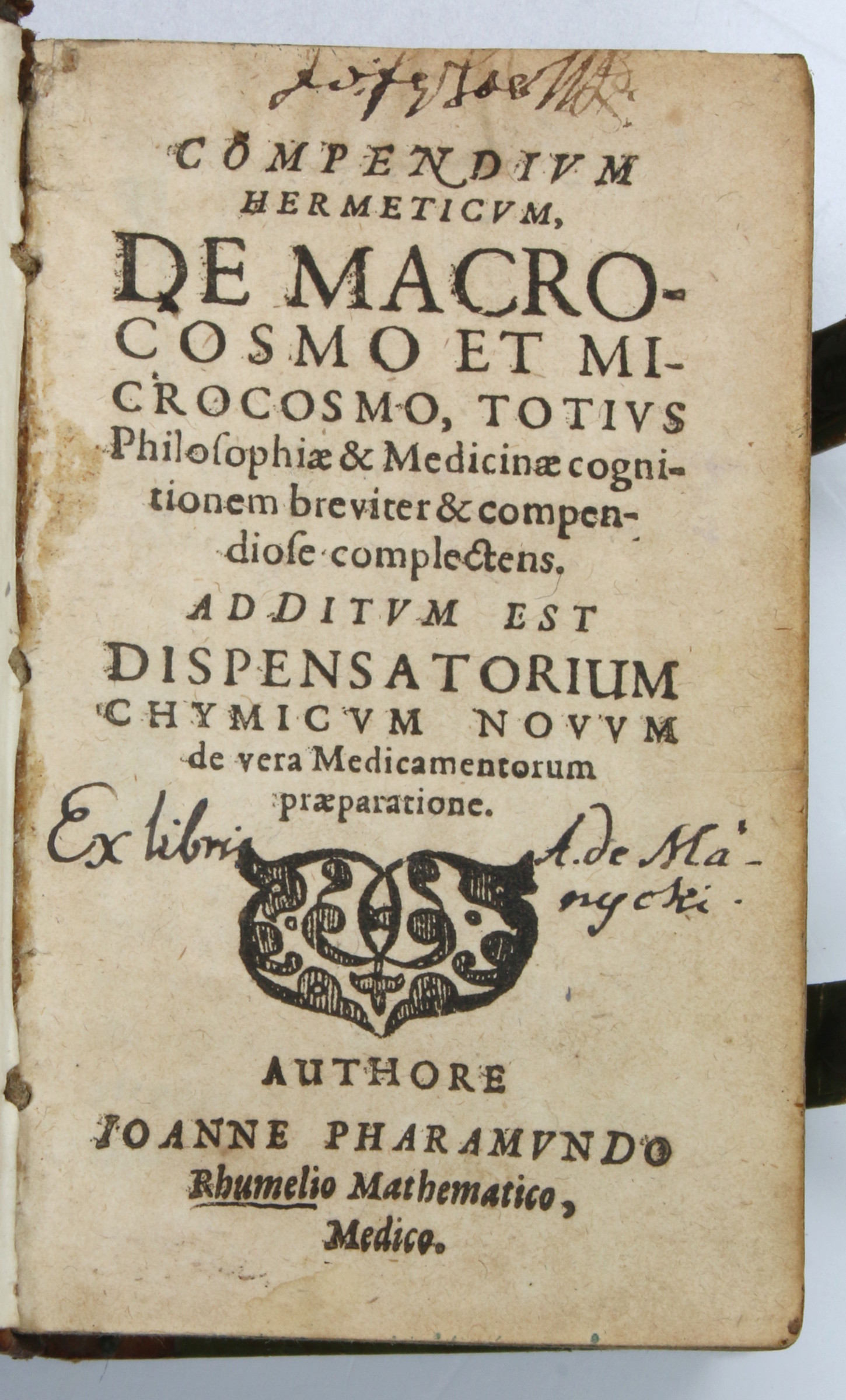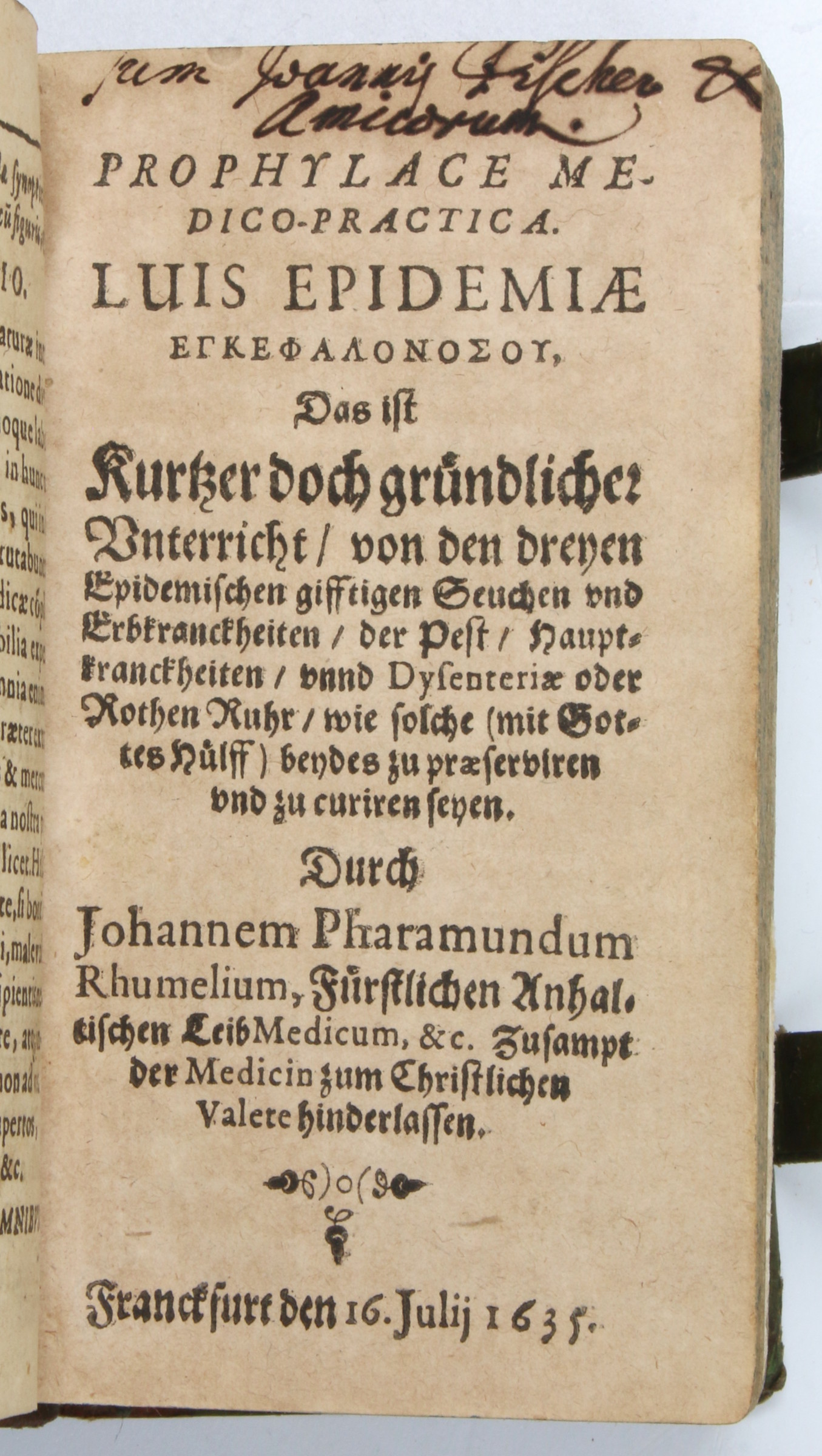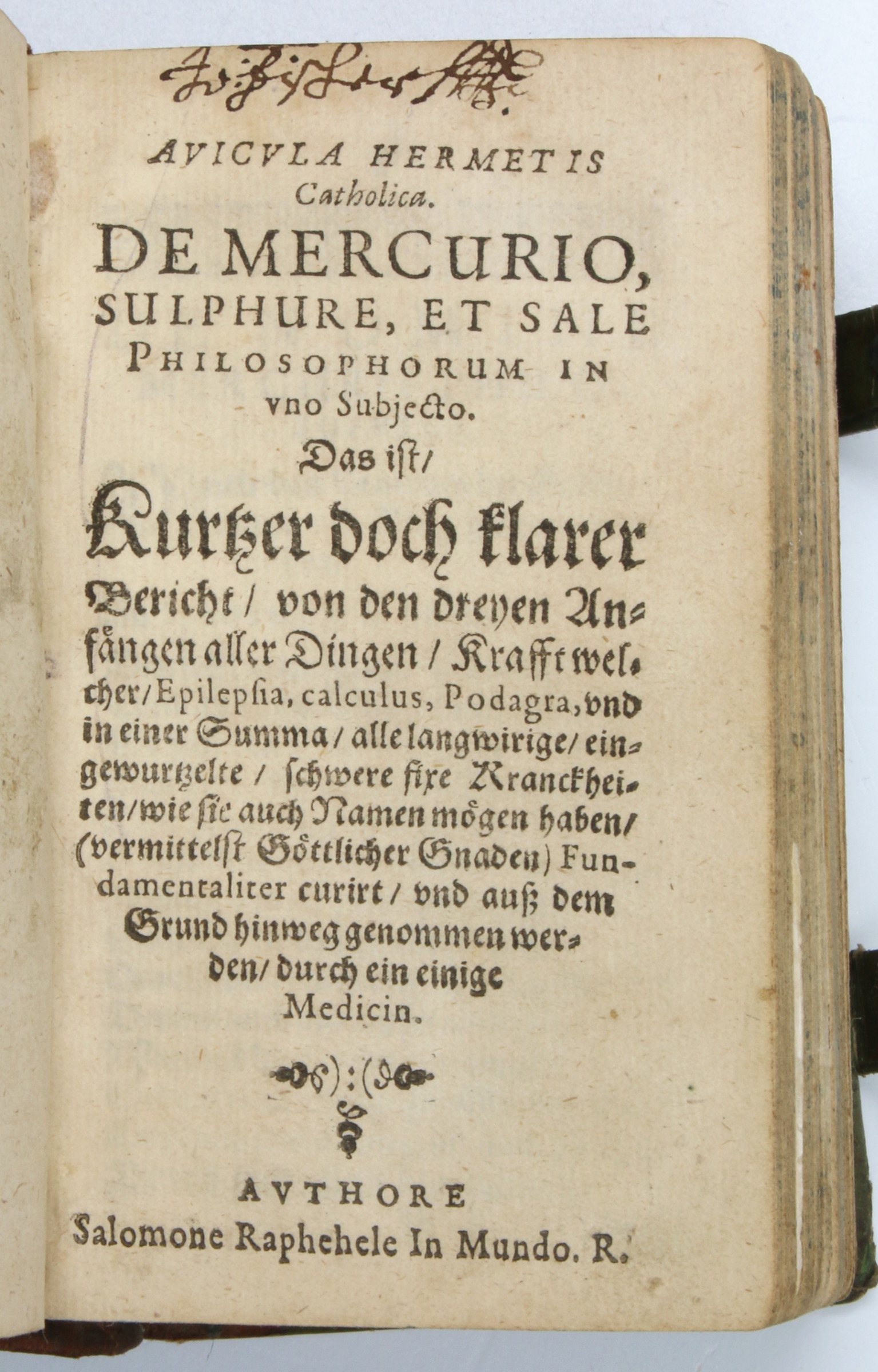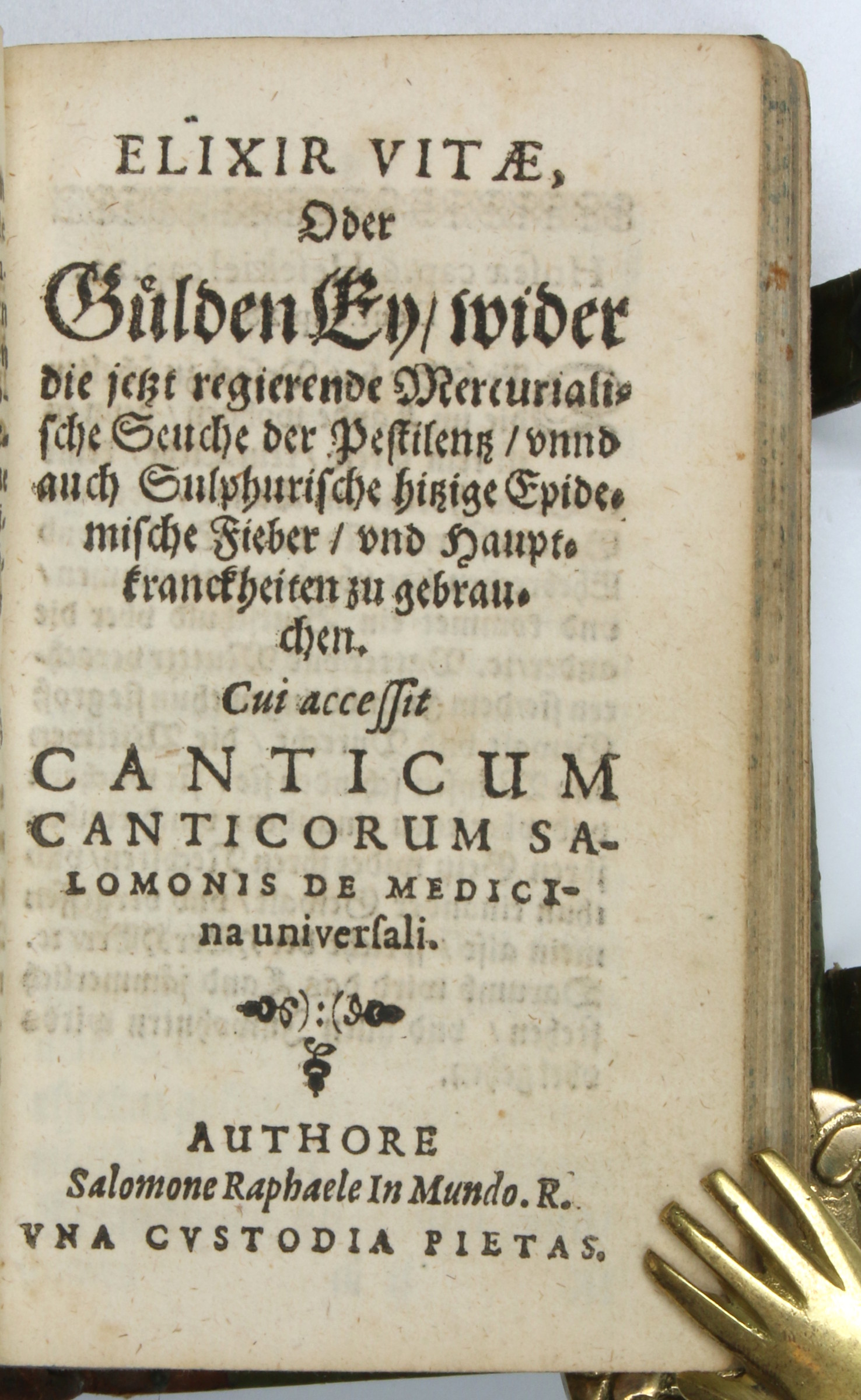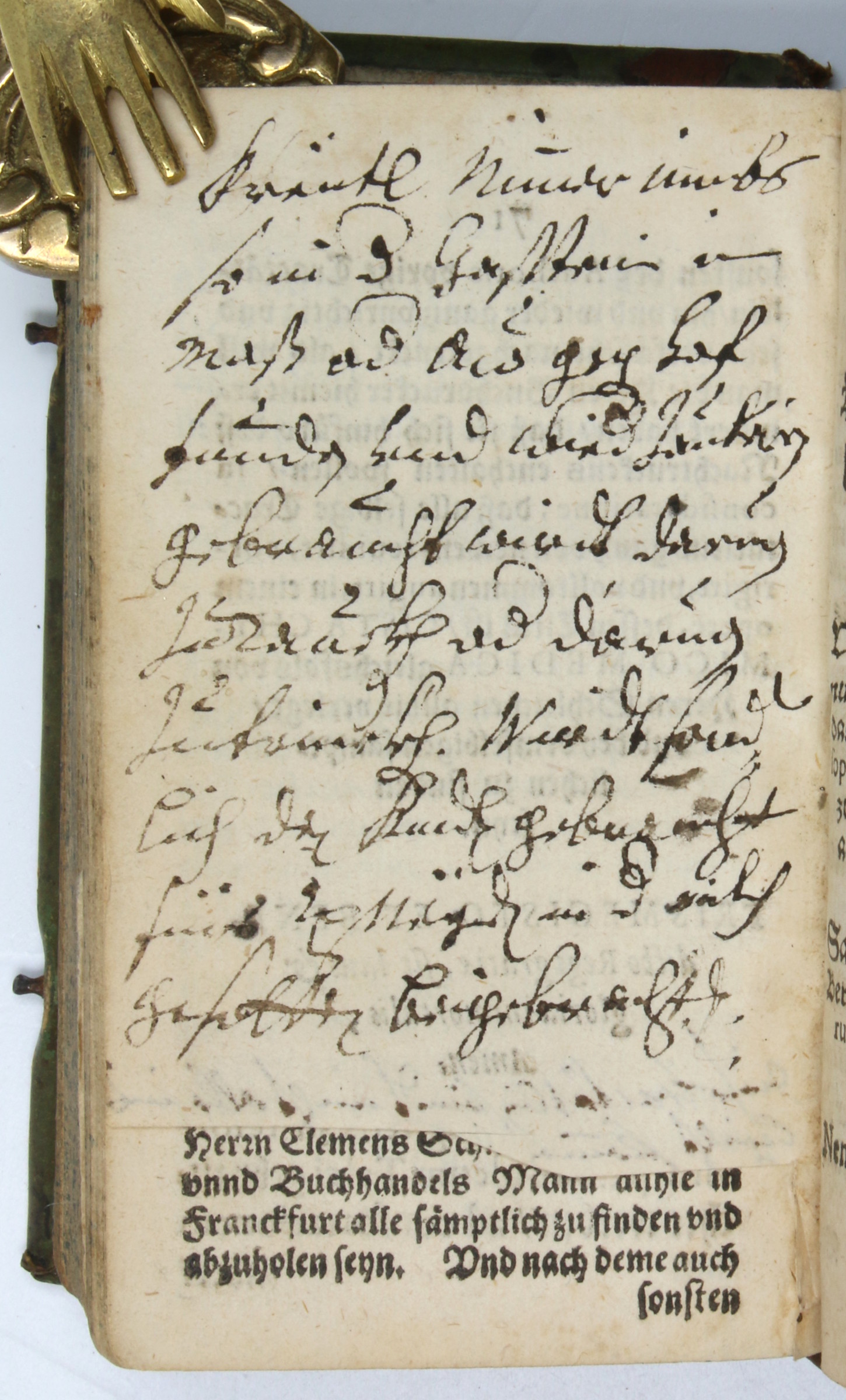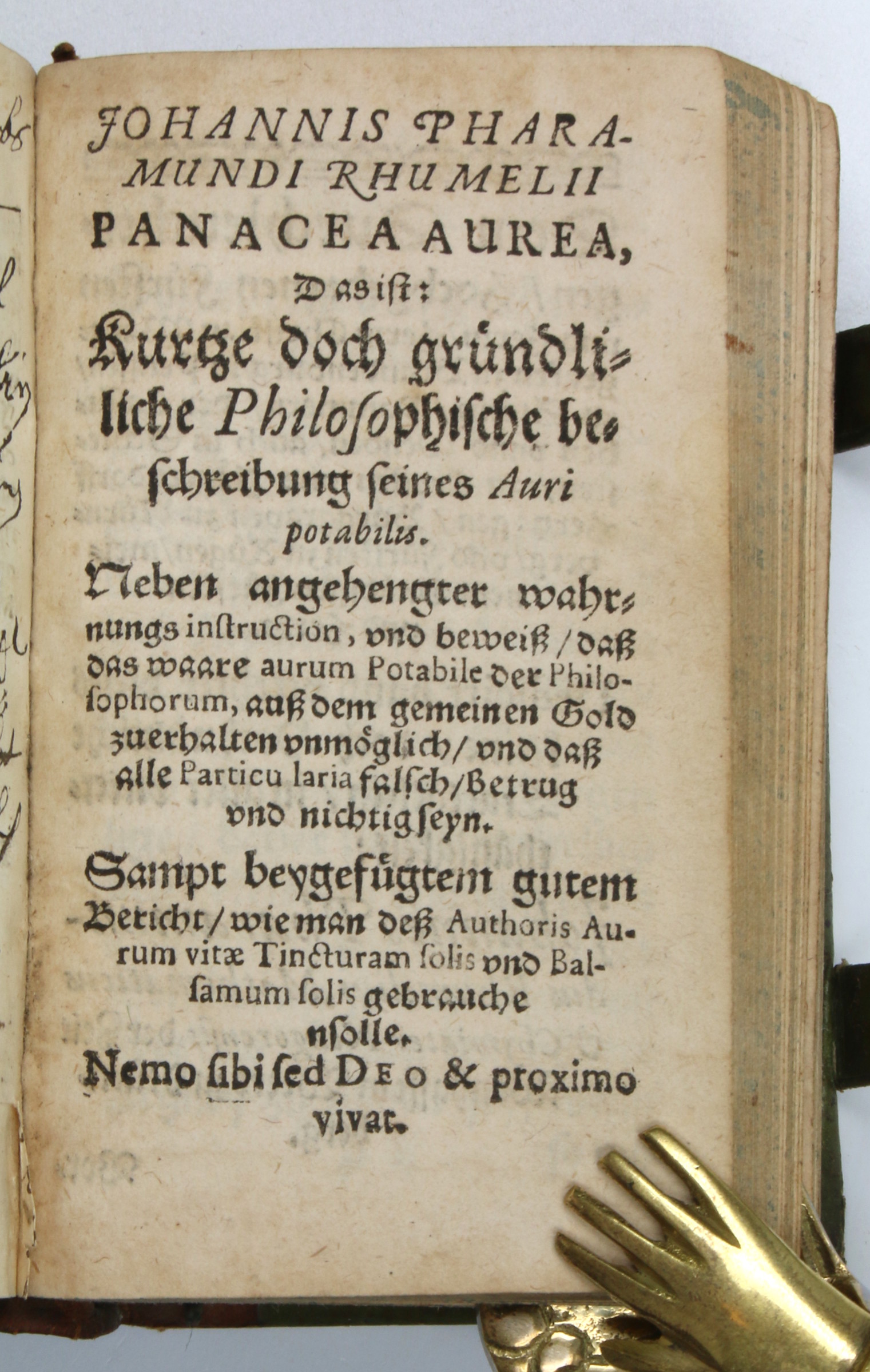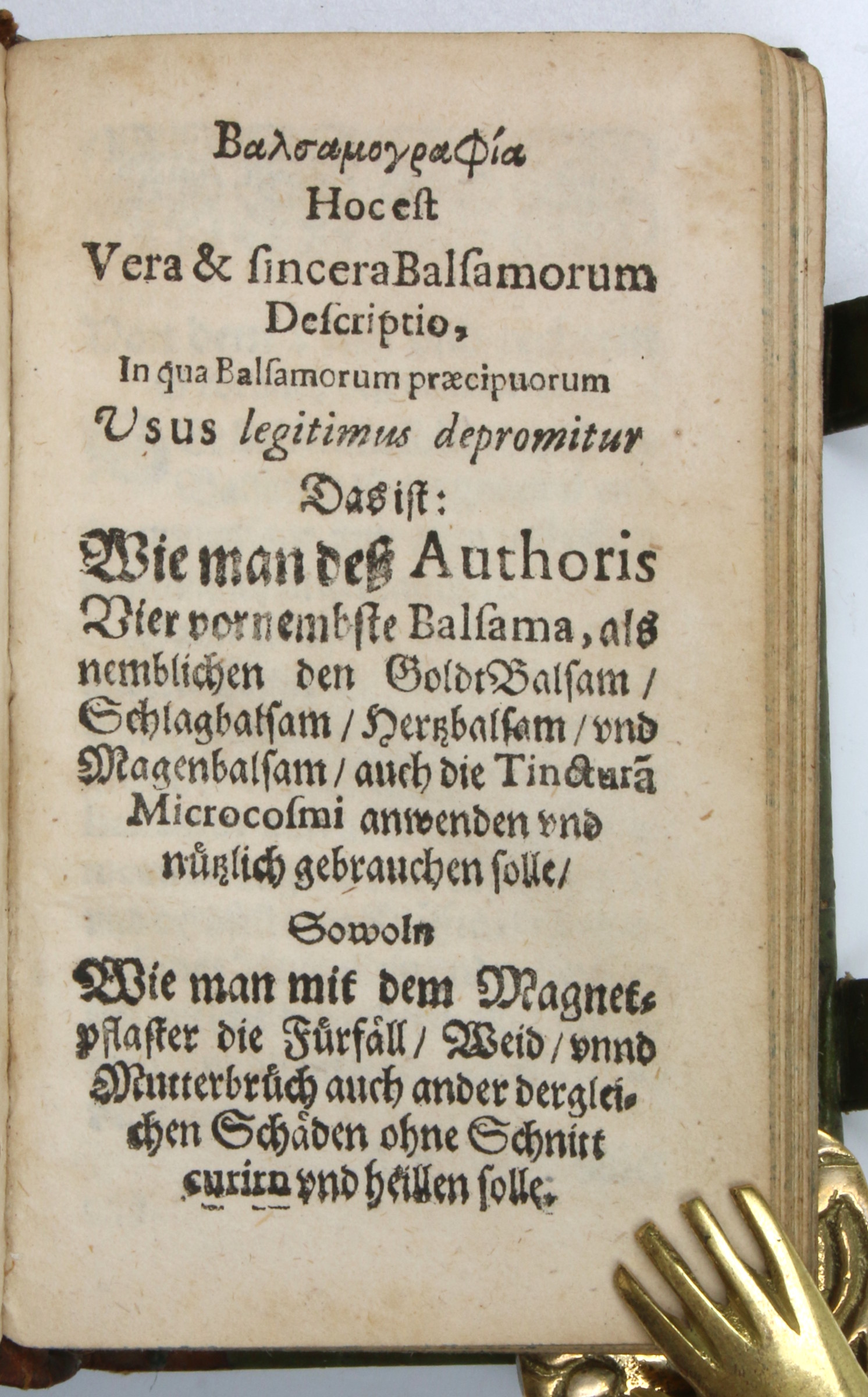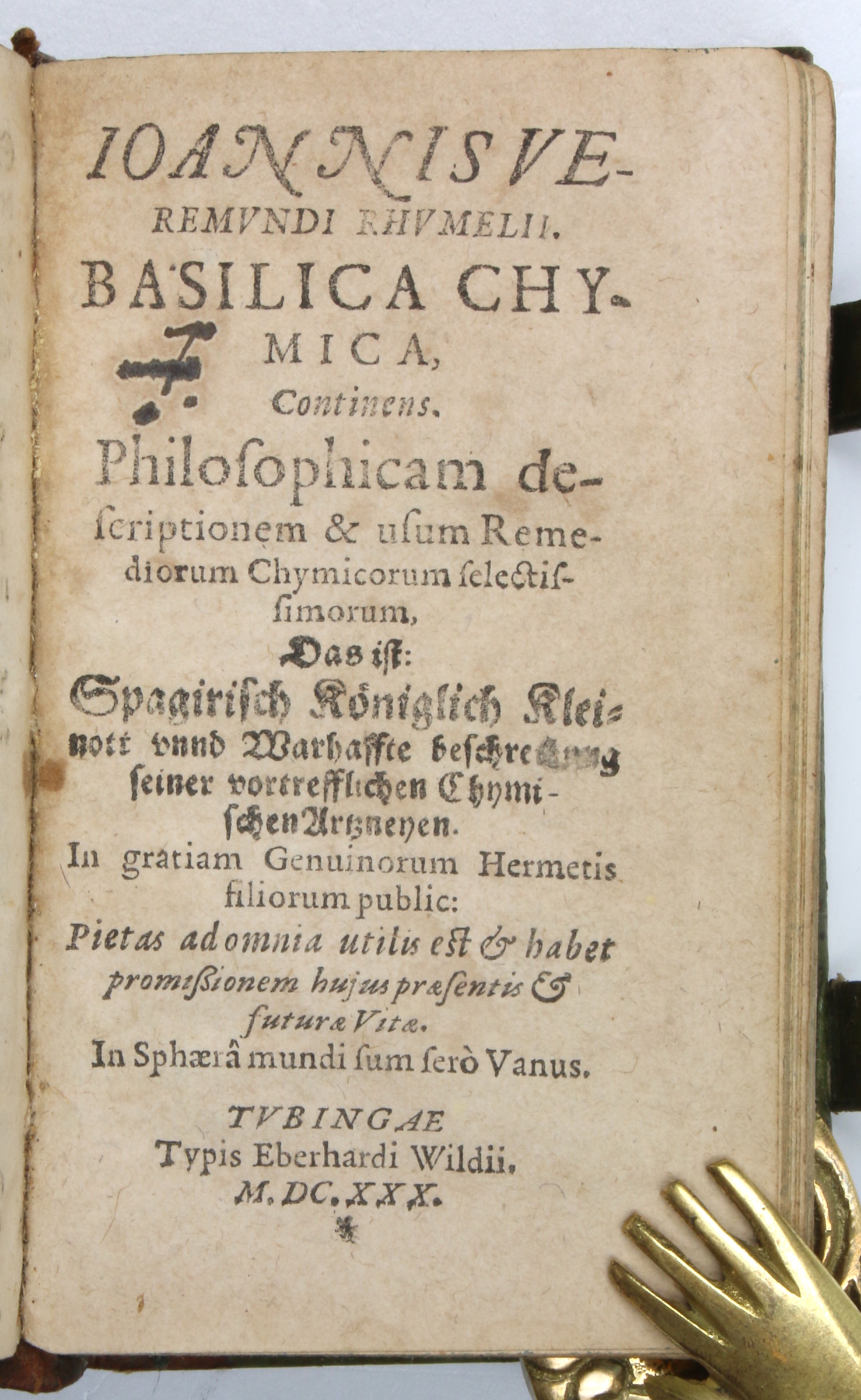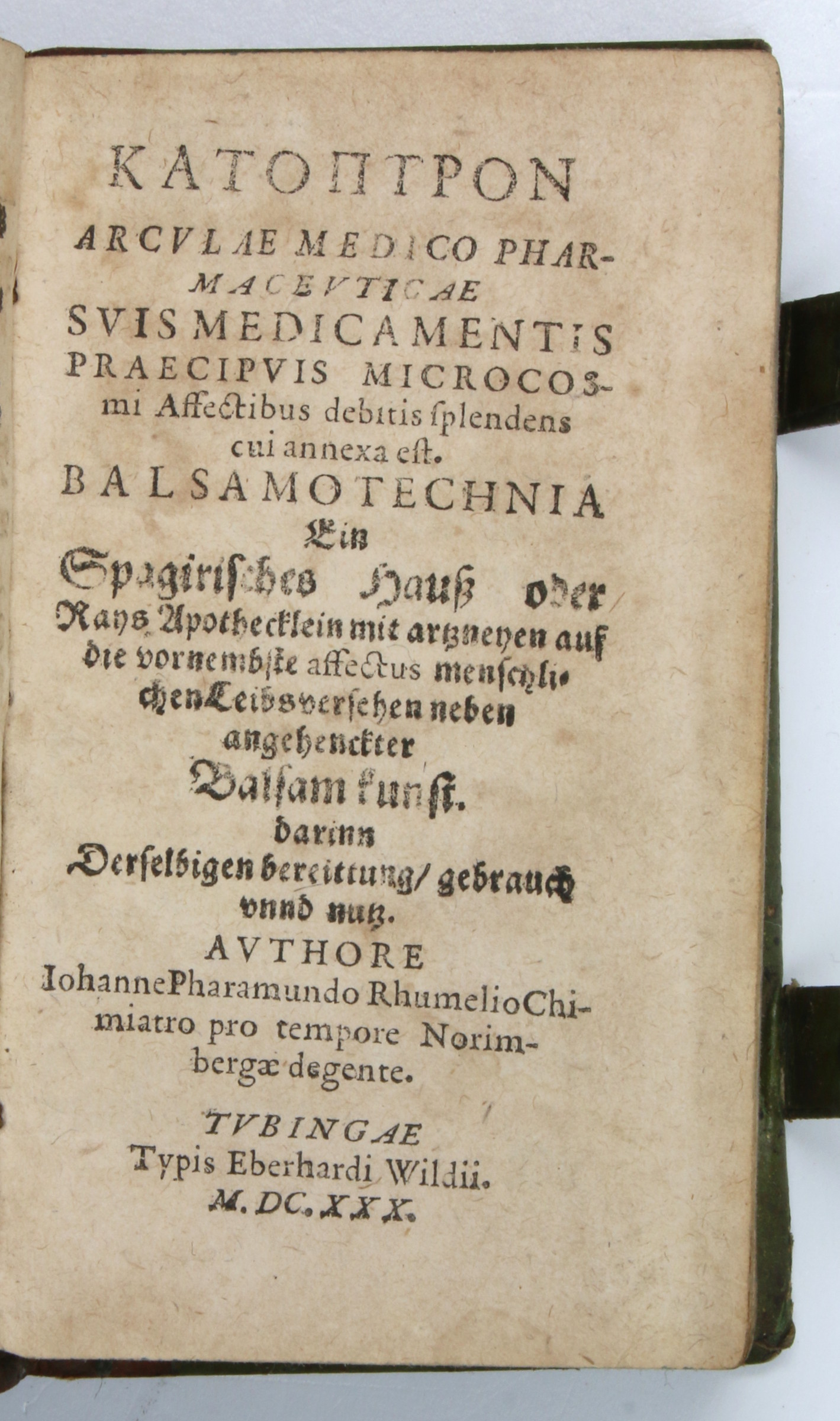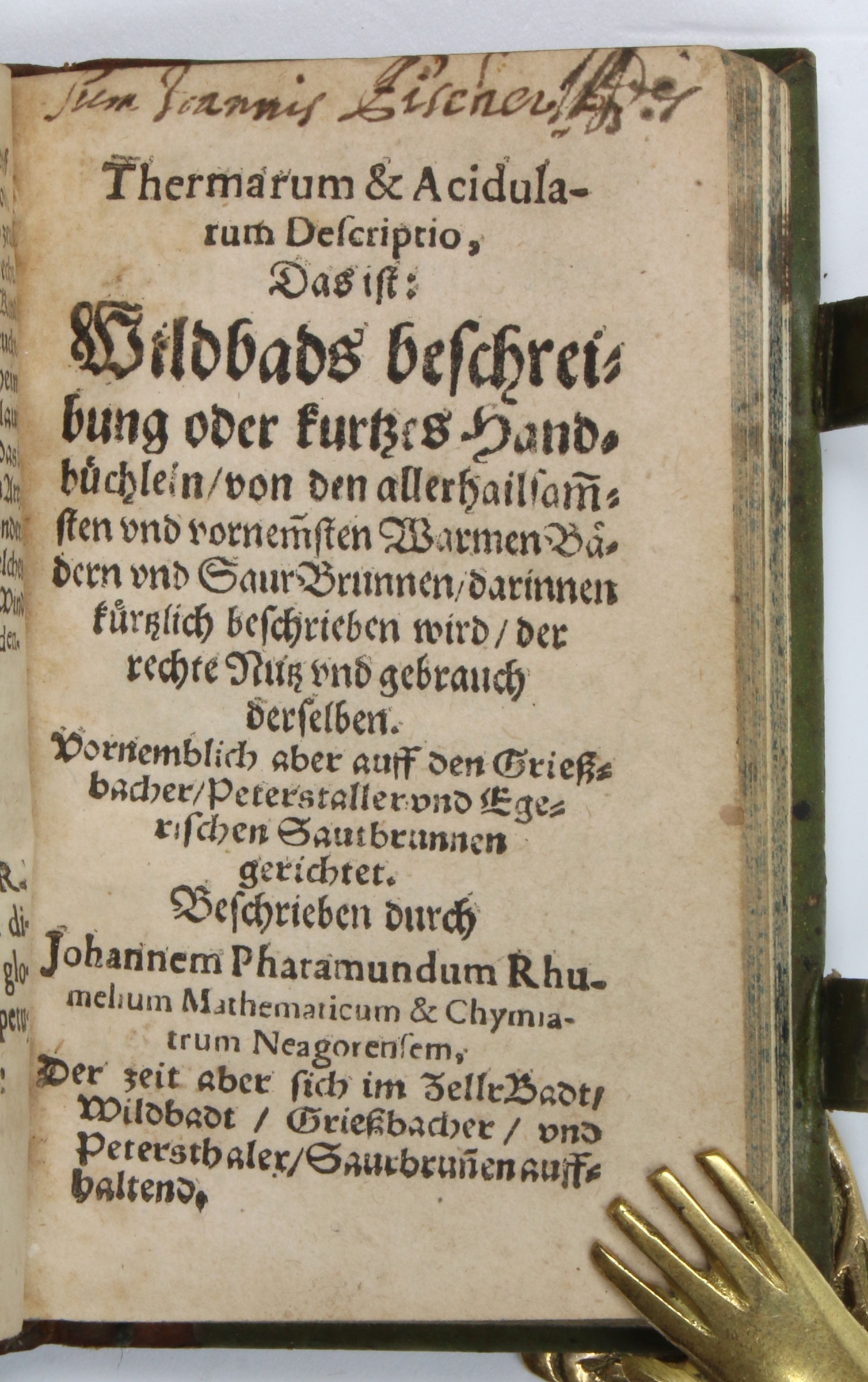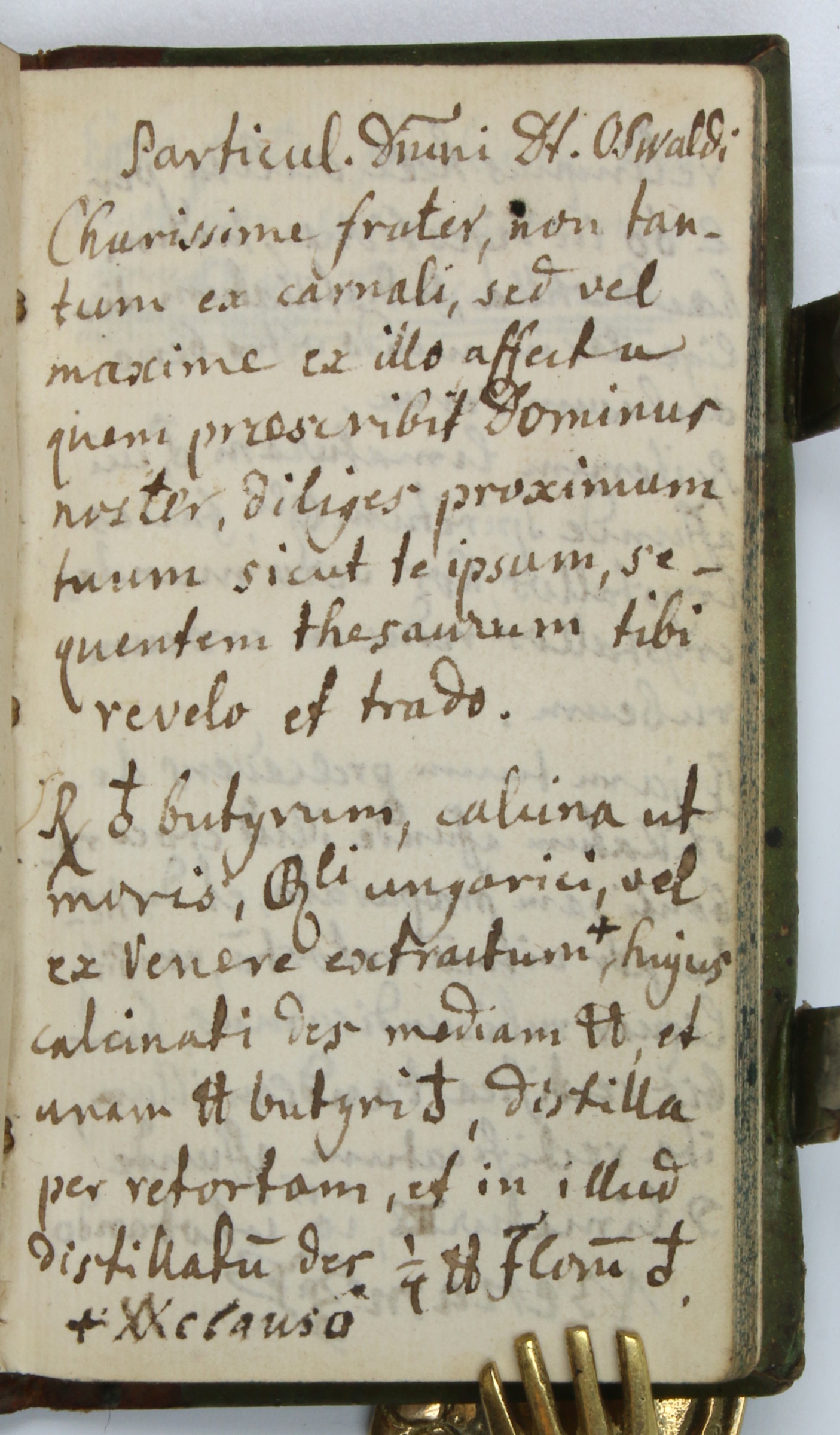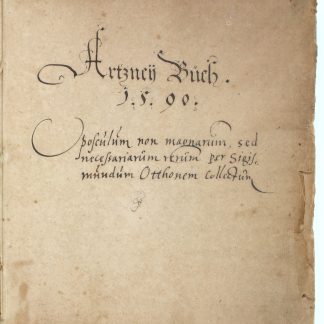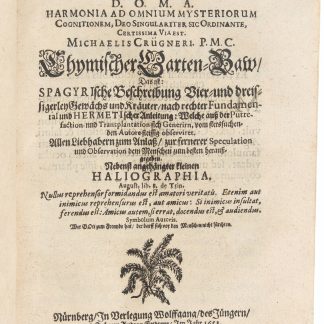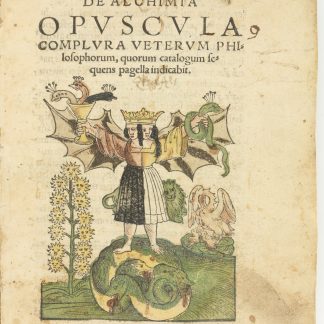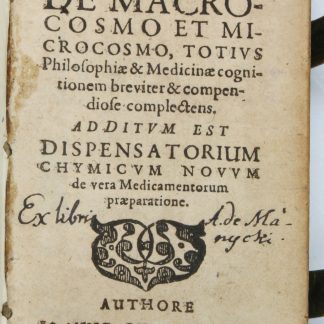Sammelband containing eleven medico-alchemical works by Rhumelius, with curious provenance
[A collection of 11 works in one volume]: Compendium hermeticum. Prophylace medico-practica luis epidemiae enkephalonosou. Avicula hermetis catholica. Elixir vitae. Panacea aurea. Balsamographia. Basilica chymica. Katoptron arculae medico-pharmaceuticae. Cura podagrica magica. Ginaecopharmaceutice. Thermarum & acidularum descriptio.
12mo. A total of ca. 670 pp. Contemporary green-dyed wooden boards with bevelled edges, spine covered with gilt leather (some damage). Two working clasps.
€ 6,500.00
Pretty sammelband comprising eleven rare works by the physician, chemist, and hermetic writer J. P. Rhumelius (ca. 1598-1639?). A native of Neumarkt in the Upper Palatinate, Rhumelius matriculated at Altdorf at the age of 14. As a fervent disciple of the Paracelsian school, he was active in Nuremberg and Plötzkau, calling himself "mathematicus et chymiatrus" and "personal physician to a Prince of Anhalt". John Webster's "Metallographia" made him known in England as an alchemist, and his works, which appeared under his own name, anonymously, and under the name of "Salomon Raphael, in mundo R[humel]", saw translations into English as well as French. In the 1630s Rhumelius also produced several magico-cabbalistic prognostication calendars.
Comprises individually:
1) Compendium hermeticum, de macrocosmo et microcosmo totius philosophiae & medicinae cognitionem breviter & compendiose complectens. [Frankfurt?], (1635). 72 pp.
2) Prophylace medico-practica luis epidemiae enkephalonosou: Das ist, kurtzer doch gründlicher Untericht, von den dreyen epidemischen gifftigen Seuchen u. Erbkranckheiten, der Pest, Hauptkrankheiten, unnd Dysenteriae oder Rothen Ruhr, wie solche ... zu praeservieren und zu curiren seyen. Frankfurt, [Schleich], 1635. 154 pp., final blank.
3) Avicula hermetis catholica. De mercurio, sulphure, et sale philosophorum in uno subiecto. Das ist, kurtzer doch klarer Bericht, von den dreyen Anfängen aller Dingen, Krafft welcher, Epilepsia, calculus, Podagra, und in einer Summa, alle langwirige, eingewurtzelte, schwere fixe Kranckheiten, wie sie auch Namen mögen haben, (vermittelst Göttlicher Gnaden) Fundamentaliter curirt, und auß dem Grund hinweg genommen werden, durch ein einige Medicin. [Frankfurt?, 1635?]. 48 pp.
4) Elixir vitae, oder Gülden Ey, wider die jetzt regierende Mercurialische Seuche der Pestilentz, unnd auch Sulphurische hitzige Epidemische Fieber, und Hauptkranckheiten zu gebrauchen. [Frankfurt?, 1635?]. 71, (1) pp. (last leaf clipped at the bottom).
5) Panacea Aurea, das ist: Kurtze doch gründliche Philosophische beschreibung seines Auri potabilis. Neben angehengter wahrnungs instruction, und beweiß, daß das waare aurum Potabile der Philosophorum, auß dem gemeinen Gold zuerhalten unmöglich und daß alle Particularia falsch, Betrug und nichtig seyn. [Frankfurt?, 1635?]. [72] pp. (last blank).
6) Balsamographia hoc est vera & sincera balsamorum descriptio, in qua balsamorum praecipuorum usus legitimus depromitur; Das ist, wie man deß Authoris vier vornembste Balsama, als nemblichen den Goldt-Balsam, Schlagbalsam, Hertzbalsam und Magenbalsam, auch die Tincturam Microcosmi anwenden und nützlich gebrauchen solle; sowoln wie man mit dem Magnetpflaster die Fürfäll, Weid, unnd Mutterbrüch ... heillen solle. [Frankfurt?, 1635?]. [12] pp.
7) Basilica chymica, continens philosophicam descriptionem & usum remediorum chymicorum selectissimorum, Das ist: Spagirisch Königlich Kleinott unnd Warhaffte beschreibung seiner vortrefflichen Chymischen Artzneyen. Tübingen, Eberhard Wild, 1630. (4), 48 pp.
8) Katoptron arculae medico-pharmaceuticae suis medicamentis praecipuis microcosmi affectibus debitis splendens. Cui annexa est Balsamotechnia. Ein Spagirisches Hauß- oder Rayß Apothecklein mit artzneyen auf die vornembste affectus menschlichen Leibs versehen neben angehenckter Balsamkunst. Tübingen, Eberhard Wild, 1630. (5), 37 pp., final blank.
9) Cura podagrica magica. Das ist: Kurtze doch eygentliche Beschreibung, wie man das schmertzhaffte Podagram und Zipperlein allein Magnetice & per Transplantationem curire solle. Nürnberg, Abraham Wagenmann, 1630. [29] pp., final blank.
10) Ginaecopharmaceutice, Das ist: WeiberArtzney, wider allerhand gefährliche, innerliche und eusserliche Kranckheiten des weiblichen Geschlechts. Neben beygefügtem Bericht, wie man die verletzte unnd versehrte Blasen, und die jenige, welche den Urin nicht halten können, curiren und heylen solle. No place, 1630. [60] pp.
11) Thermarum & acidularum descriptio, Das ist: Wildbads beschreibung oder kurtzes Handbüchlein, von den allerhailsam[m]sten und vornem[m]sten Warmen Bädern und Saur-Brunnen, darinnen kürtzlich beschrieben wird, der rechte Nutz und gebrauch derselben. Vornemblich aber auff den Grießbacher, Peterstaller und Egerischen Saurbrunnen gerichtet. No place, (1630). [57] pp., final blank.
Extremeties of binding rubbed; spine wormed and chipped. Interior browned and stained due to paper stock; occasional remarginings. The end of the "Elixir vitae" contains a contemporary note in German manuscript (slightly trimmed at the beginning). Bound at the end of the volume are an additional 48 blank leaves, the first three pages of which contain an alchemical recipe in contemporary Latin manuscript (explicit: "Ecce frater fraterne tibi revelavi secretum magn. thesaurum").
Provenance: front pastedown has handwritten red ink ownership of Joseph Georg Stampersky (fl. ca. 1710), procurator at the Prague archiepiscopal consistory. A little later, the book was apparently owned by the Hungarian painter Ádám Mányoki (1673-1757), who signs on the first title-page ("Ex libris A. de Mányoki"). Subsequently in the library of the Hungarian noble family Szent-Iványi (their armorial bookplate on the verso of the first title-page) and then in that of the Pálffy-Erdödy family (a 19th century etched bookplate with handwritten inset label "Palfy m.p."). Latterly in the Czech L'achki collection with their stamp to the lower pastedown.
Ferguson II, 266f. Cf. Rosenthal 729. Duveen 506f. Biobibliographisches Handbuch der Kalendermacher von 1550 bis 1750 (Univ. Bremen/DFG, online). Cf. Klaus Matthäus, Zur Geschichte des Nürnberger Kalenderwesens, in: AGB IX (1969), cols. 965-1396, for Rhumelius see cols. 1145f.

